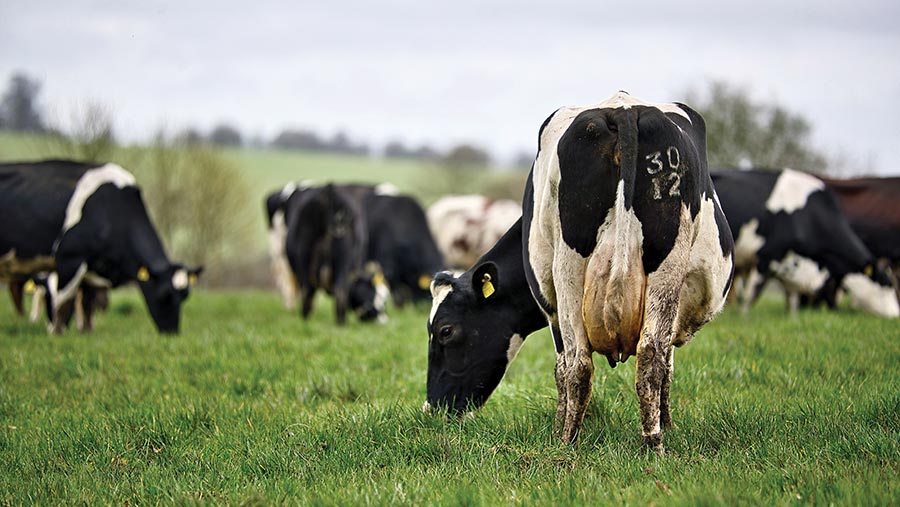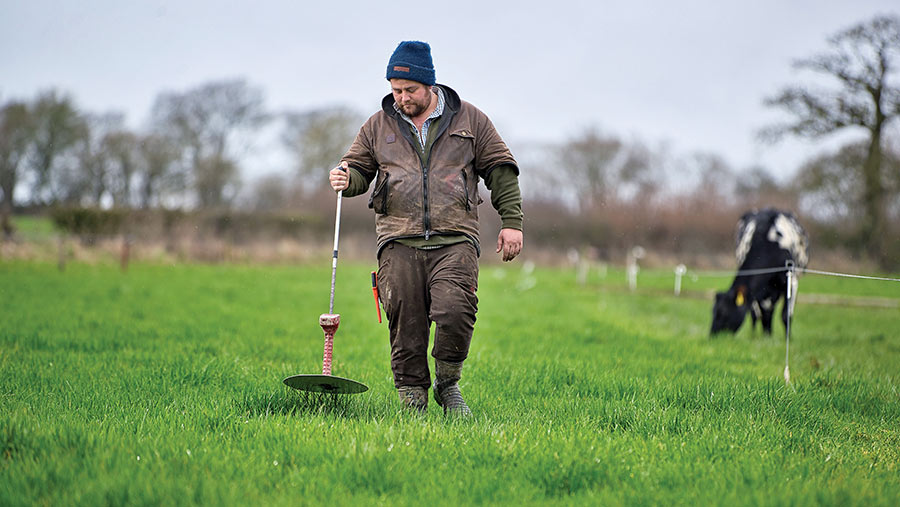How to manage dairy cows at grass as seasons get more extreme
 © Richard Stanton
© Richard Stanton Regularly measuring grass growth, assessing trends and being adaptable to changing weather patterns are helping one grass-based dairy manage extreme weather conditions.
Herd manager Antony Mitchell milks 600 spring- and autumn-calving cows for Tom Blanchard across 600ha (1,482 acres) near Marlborough, Wiltshire.
Antony says the past two seasons have been polar opposites: 2022 brought drought conditions, which saw grass yields fall to 13.9t dry matter (DM)/ha, while the farm grew 17.1t DM/ha in 2023, but wet weather made utilisation tricky.
See also: 6 tips for improving your dairy farm’s sustainability
According to LIC consultant Piers Badnell, the five years of grass growth data up to 2022 show low rainfall is hitting summer growth.
There is also a trend towards higher growth during autumn and winter, owing to milder temperatures.
Antony is adapting his grassland management to cope with this and says measuring grass regularly to control average farm cover is crucial.
Farm facts: Wolfhall Farm, Marlborough, Wiltshire
- Milking 600 cows, split block
- 175ha grazing platform
- Supplying milk to Cadbury
- Herds averaging 6,000 litres at 4.6% butterfat and 3.7% protein. Aim is to increase yield to 6,500 litres as cow maturity increases
- Feeding 1.2t concentrate a cow a year to autumn calvers and 500-800kg to spring calvers
- Stocking rate 3.4 cows/ha
Spring grass management
He also says it is important to stick to the spring rotation planner and suppress the urge to graze more grass if growth is strong.
“It can be tempting to graze quicker or graze more grass, but it can come back to bite you. You don’t want to get yourself into a deficit by the end of March. Set your round length and feed budgets and work off that,” he advises.
At Wolfhall Farm, spring calving has been delayed by two weeks (to 1 March) to better control grass demand.
This has helped reduce winter silage supplementation, maximise grass intakes and better balance demand between the two herds, with the autumn herd calving from 15 August.
Furthermore, the blocks have been tightened from 12 weeks to six to ensure maximum stocking rate is reached quickly at turnout.
The rotation length starts at 120 days with an opening cover of 2,427kg DM/ha, and by “magic day” – when supply equals demand – average farm cover is about 1,900kg.
“We are going into our second round by the end of March, which is quite early,” says Antony.

Antony Mitchell © Richard Stanton
Summer grass management
Measuring grass twice-weekly during the summer helps him foresee any problems quickly.
“The plate meter is the cheapest tool a farmer can have. You need to measure grass as hard through a deficit. We measure grass twice a week from April through to mid-June.”
He uses the long-range weather forecast alongside AgriNet data to predict a wedge for the week and run different scenarios.
A key thing to remember is that demand is met by rotation length, says Antony.
In July 2022, when growth rate dropped below demand and temperatures peaked at 35C, he focused on maintaining average farm cover by bringing paddocks into the platform and lengthening the rotation to 100 days.
Cows were given supplementary feed indoors to minimise heat stress and milking was pushed back to 8pm when it was cooler.
The important thing, he says, is to act fast and protect grass quality at all costs, especially during a drought in May and June, when grass can go to head quickly and reduce palatability.
In 2022, he still targeted exit covers of 1,500kg DM/ha to maintain pasture quality.
Antony is not afraid to reset residuals using mechanical intervention, but he prefers pre-mowing to topping to avoid leaving dry hay on the ground.
“Ideally, cows should do all the work; we only do this as needed,” he stresses.
Piers says that during a dry period, farmers can get caught out by the “tailspin of death”. This is where they graze covers too low and run too short a rotation, which results in running out of grass.
“The third leaf on a perennial ryegrass plant represents 45% of total yield. You can push grass yields up by extending the rotation length a little, to grow the third leaf fully or a little more,” he explains.
To avoid being unable to manage a sudden growth spurt when rain does arrive, Antony aims to have one-third of the platform at a cover of 1,500-1,900kg, another third at 1,950-2,400kg, and the final third at 2,400-3,000kg.
In periods of surplus grass growth, fields are removed to make silage bales.
“You look at your growth curve in the shoulders, and that gap in the middle seems to be getting deeper and longer, so when you have surplus, you need to take it to fill the gap,” Piers advises.
Autumn/winter grass management
Using an autumn rotation planner is as important as using a spring one, says Antony.
One advantage of the milder autumn/winter weather is that it is lengthening the grazing season. This is something Antony is capitalising on, with cows grazed until December.
He is now typically achieving 10-12 rounds annually.
The autumn herd calves on standing hay and is housed by night in October, but cows still graze 6-7kg of grass daily with maize and silage.
Spring-calving cows are out full-time until mid-December. During the final 80-day round, he aims to graze 60% of the platform by 5 November and the remaining 40% by 20 December.
During the final 50 days of the last round, spring milkers are supplemented with fodder beet and maize and are milked once daily.
Antony aims for a closing cover of 2,350-2,400kg DM/ha to prevent canopy closure, which slows down regrowth.
“We have a high demand at turnout, and we can get through it,” he says. “Anything with higher covers can be grazed with beef or youngstock through mid-December to replenish quality for spring.”
From 20 December, paddocks will be rested for 60-80 days over winter, on average, but measuring during this time is still key to guide management.
“We measure weekly through the autumn/winter. It is very important,” he says.
“In 2022, we measured twice a week in September and October because grass growth was strong, and we grew 7.5t/ha that autumn. We were still taking surplus in September.”
Future
About 20% of the platform has now been reseeded with a mix of 70-80% white clover and ryegrass along with 20% of chicory and plantain to improve drought tolerance.
After fodder beet, maize is grown and then grass is reseeded in the autumn.
“Cut and weigh is the best option, but unless you have a lot of chicory, which is stemmy, these leys do measure like ryegrass and clover with a plate meter,” says Antony.
“You must adapt to what the season is throwing at you. Grazing is complicated but basic. If you stick to the basics, you do a good job.”
Take-home messages
- Use spring and autumn rotation planners
- Record grass growth regularly and plot trends
- Control average farm cover by controlling demand
- Be adaptable and react quickly to what is in front of you
